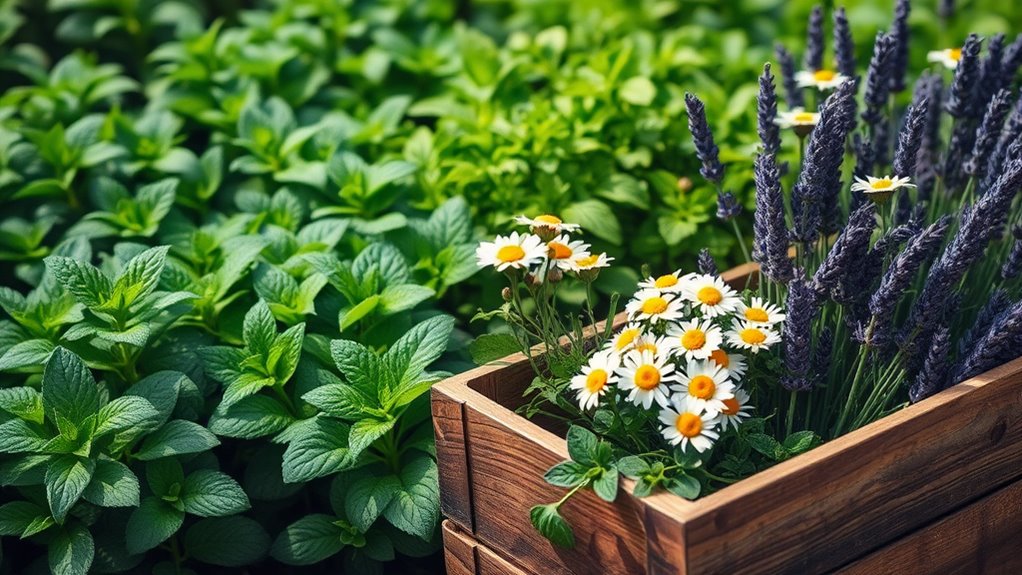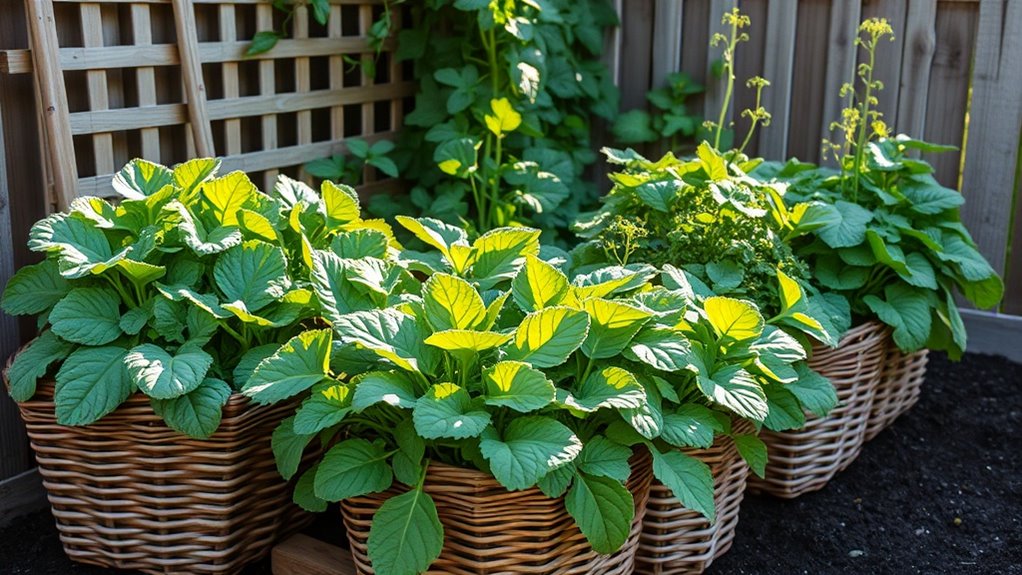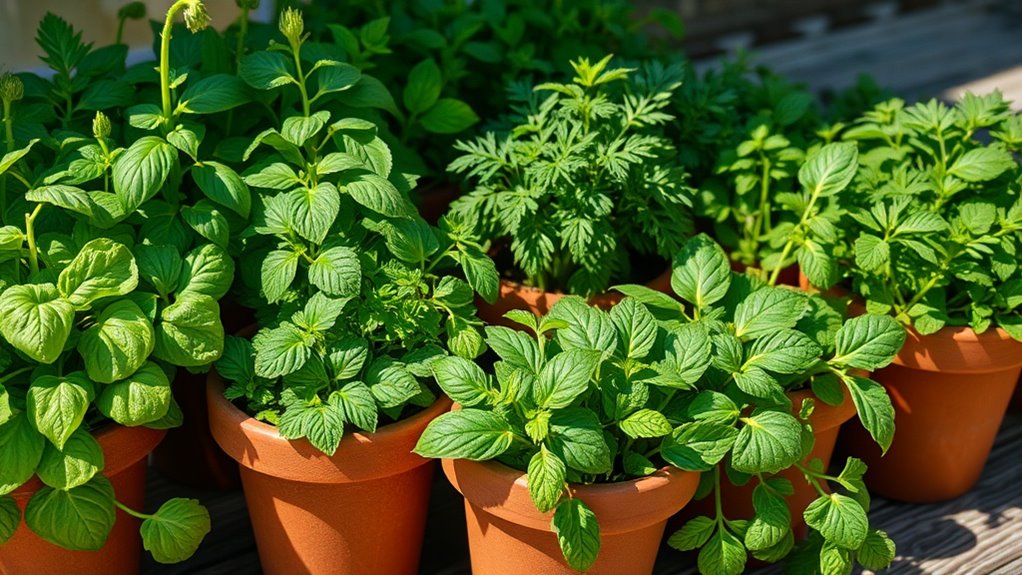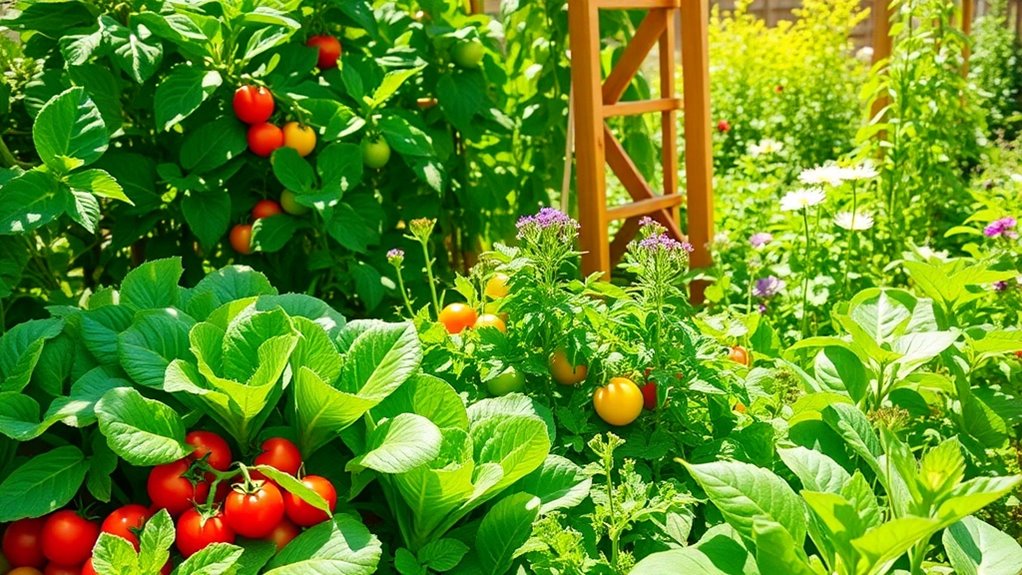The Easiest Herbs to Grow for Homemade Teas and Remedies
Imagine stepping into your garden, where the air is filled with the soothing scents of chamomile and peppermint. These herbs not only add flavor to your homemade teas but also offer a range of health benefits. With just a bit of sunlight and well-drained soil, you can easily cultivate these plants right at home. Curious about which herbs you should start with to enhance your wellness journey?
Key Takeaways
- Chamomile is easy to grow and yields abundant blossoms for calming homemade teas.
- Peppermint thrives indoors and has digestive and headache-relieving properties, making it great for teas.
- Lemon Balm is low-maintenance and promotes relaxation and cognitive clarity for soothing remedies.
- Ginger grows well in warm environments and can be used in teas for digestive support and cold relief.
- Basil and Lavender are simple to grow, enhancing both culinary dishes and providing calming aromas for teas and remedies.
Chamomile: The Calming Flower
Chamomile, with its delicate white petals and sunny yellow center, is more than just a pretty flower; it’s a powerhouse of calming effects.
This herb is perfect for teas, offering a soothing experience you’ll cherish after a long day.
Growing chamomile at home is simple; it thrives in well-drained soil and sunny spots. Just a few plants can yield an abundance of blossoms, ready for your homemade brews.
When steeped, chamomile’s natural compounds help ease anxiety and promote better sleep. Additionally, easy-to-grow herbs like chamomile can be a great introduction to herbal gardening for beginners.
Peppermint: The Refreshing Herb
Peppermint is a vibrant herb that not only thrives indoors but also offers a refreshing burst of flavor to your teas. You’ll love how its health benefits can enhance your well-being, from soothing digestion to providing a cooling effect. Additionally, peppermint can flourish with adequate light requirements and proper care, making it an ideal choice for indoor gardening. Let’s explore how to grow it at home and incorporate it into your favorite herbal concoctions.
Growing Peppermint Indoors
Imagine a fresh burst of aroma filling your kitchen as you nurture your indoor peppermint plants.
To get started, choose a bright spot with indirect sunlight; peppermint thrives in warm, well-lit environments. Use a pot with drainage holes and fill it with quality potting soil.
Water your plants regularly, keeping the soil damp but not soggy. Trim the leaves often to promote bushy growth.
Remember, peppermint can spread quickly, so consider keeping it in its own pot.
With just a little attention, you’ll enjoy the vibrant scent and lush greenery, perfect for tea or culinary delights. Happy growing!
Health Benefits of Peppermint
After cultivating your indoor peppermint, you’ll soon discover that this herb offers more than just a delightful aroma.
Rich in menthol, peppermint can soothe digestive issues and relieve headaches.
You might find it effective for reducing nausea and improving concentration as its invigorating scent stimulates your senses.
Additionally, peppermint has anti-inflammatory properties that can ease muscle tension and improve respiratory function.
With its natural antibacterial qualities, it can help freshen your breath too.
Uses in Herbal Teas
A steaming cup of herbal tea can be a comforting ritual, and peppermint shines as a standout ingredient in this soothing brew.
Its invigorating aroma awakens your senses, while its crisp flavor refreshes.
You can steep fresh or dried peppermint leaves for a few minutes to extract their essential oils.
Enjoy it alone or blend it with chamomile for relaxation or ginger for a digestive boost.
Adding honey elevates the sweetness, making your tea even more delightful.
Whether you sip it hot or iced, peppermint tea is an uplifting choice that rejuvenates both body and mind.
Lemon Balm: The Uplifting Leaf
Lemon balm is an easy-to-grow herb that thrives in sunny spots with well-drained soil. Not only does it offer a delightful lemony scent, but it also boasts numerous health benefits, from reducing stress to aiding digestion. This herb is known for its ability to promote overall health through its calming effects and support for digestive health. Let’s explore how to care for this uplifting leaf, its medicinal uses, and the best ways to harvest and prepare it for your homemade teas and remedies.
Growing Conditions and Care
While you might think that growing lemon balm is a challenging task, it actually thrives with minimal effort in the right conditions.
This herb loves well-draining soil and plenty of sunlight, so choose a spot that gets at least six hours of direct light daily.
Water it regularly, but don’t let it sit in soggy soil; it prefers moist, not wet, conditions.
Pruning encourages bushier growth, so snip back the stems occasionally.
Lemon balm’s resilience helps it withstand a variety of temperatures, but it flourishes best in mild climates.
With these simple care tips, you’ll soon enjoy a delightful lemon-scented harvest.
Health Benefits and Uses
Known for its uplifting aroma and calming properties, lemon balm offers a wealth of health benefits that can enhance your well-being. You can use this delightful herb to relieve stress, improve sleep quality, and soothe digestive issues. Imagine sipping a warm cup of lemon balm tea after a long day, feeling the tension melt away.
| Health Benefit | Description |
|---|---|
| Stress Relief | Alleviates anxiety and tension |
| Sleep Aid | Promotes restful sleep |
| Digestive Support | Eases bloating and discomfort |
| Mood Booster | Enhances overall mood |
| Cognitive Function | Improves focus and clarity |
Add lemon balm to your daily routine and experience its uplifting effects!
Harvesting and Preparation Tips
To enjoy the full benefits of lemon balm, it’s essential to harvest and prepare it correctly.
Pick the leaves in the morning after the dew has dried for the freshest flavor and aroma. Use clean, sharp scissors to snip the stems just above a leaf node, encouraging bushier growth. Rinse the leaves gently to remove any dirt or pests.
For tea, steep 1-2 teaspoons of fresh leaves in hot water for 5-10 minutes.
If you’re drying them, hang bundles upside down in a cool, dark place. Store dried leaves in airtight containers away from light to preserve their uplifting qualities.
Ginger: The Zesty Root
Ginger, with its warm and spicy flavor, isn’t just a culinary delight; it’s also a powerhouse of health benefits.
Growing ginger at home is simple—just plant a piece of ginger root in rich, well-drained soil.
It thrives in warm, humid environments, so keep it in a sunny spot.
As it grows, you can harvest fresh rhizomes.
Use ginger in teas for soothing digestion or to relieve cold symptoms.
Its anti-inflammatory properties can ease aches and pains.
Whether you slice it for a refreshing drink or steep it for a calming remedy, ginger’s zesty kick makes it a must-have herb in your garden. Additionally, ginger is known for its anti-inflammatory properties, which can significantly improve overall health.
Lavender: The Aromatic Blossom
Lavender’s enchanting fragrance and vibrant blooms make it a favorite among gardeners and herbal enthusiasts alike.
This versatile herb not only beautifies your garden but also offers fantastic benefits for homemade teas and remedies. Lavender is known for its medicinal properties, which enhance its appeal in culinary uses.
Here’s how you can enjoy lavender:
-
Calming Tea: Brew dried lavender flowers to create a soothing tea that helps reduce anxiety and promote relaxation.
-
Aromatherapy: Use lavender essential oil in diffusers for its calming effects, perfect for stress relief.
-
Sleep Aid: Place sachets of dried lavender under your pillow to enhance sleep quality and combat insomnia.
Growing lavender is rewarding and simple, so give it a try!
Basil: The Versatile Culinary Herb
While lavender brings a calming presence to your garden, basil offers a burst of flavor and versatility that’s hard to beat. This aromatic herb thrives in sunny spots and well-draining soil, making it easy for you to grow.
With its rich, peppery taste, basil enhances dishes like pasta and salads, but it’s also great for homemade teas. Simply steep fresh basil leaves in hot water for a refreshing herbal infusion.
Plus, basil’s anti-inflammatory properties can help soothe minor ailments. With just a bit of care, you’ll enjoy a continuous supply of this delightful herb all season long. You can even grow basil in water without the need for soil for a hassle-free gardening experience.





